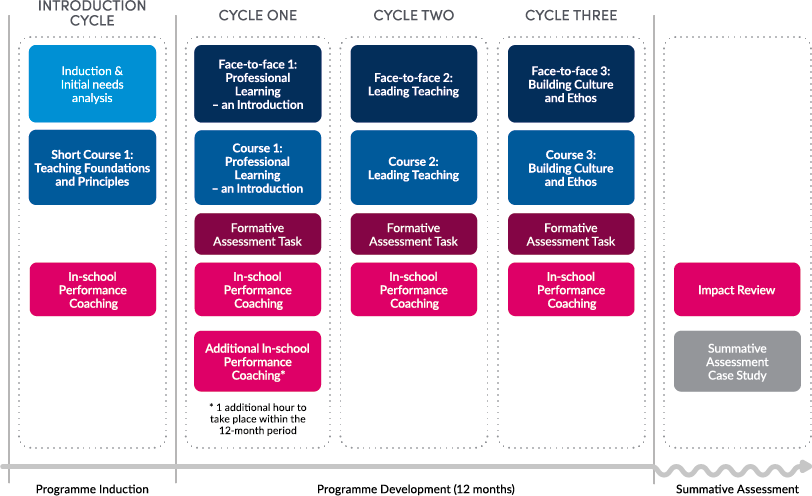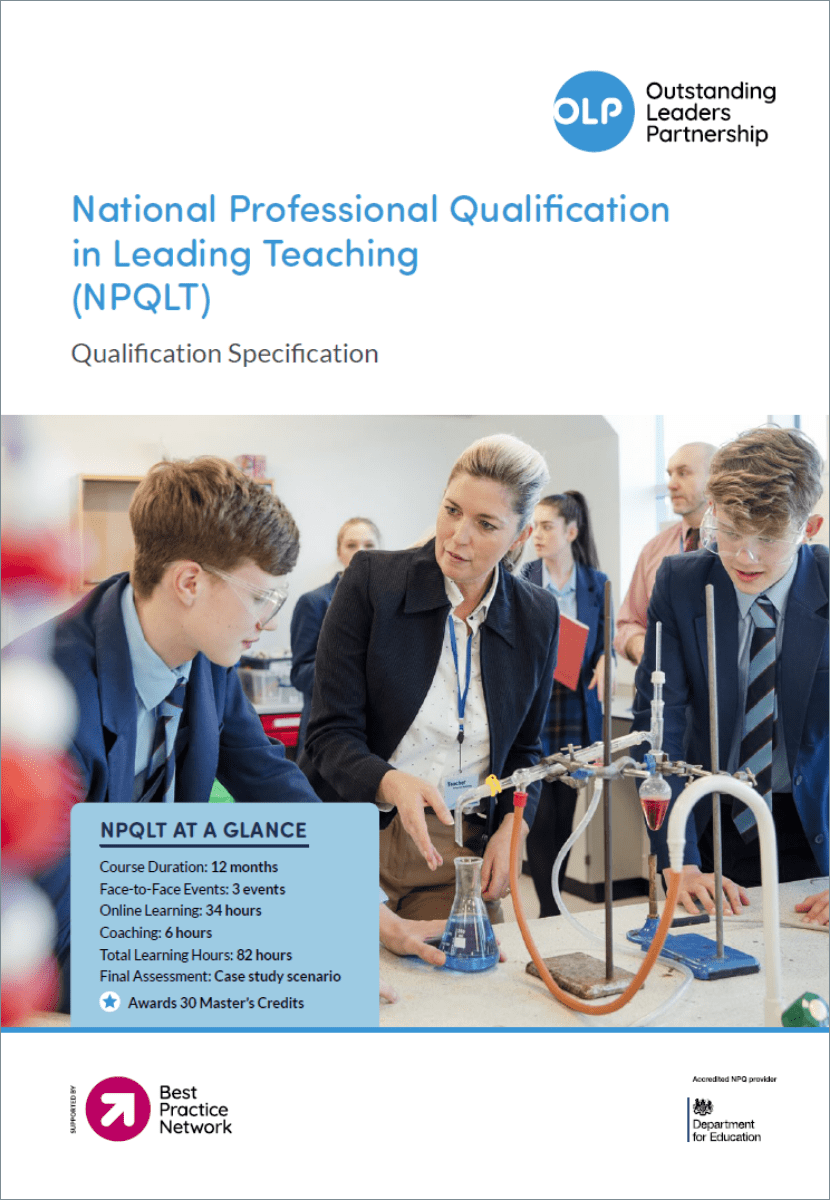National Professional Qualification
for Leading Teaching (NPQLT)
For teachers who have, or are aspiring to have, responsibilities for leading teaching in a subject, year group, key stage or phase.
![]() Deepen your understanding of pedagogy and the science of learning
Deepen your understanding of pedagogy and the science of learning
![]() Awards 40 Master's Credits
Awards 40 Master's Credits
![]() Develop the skills to help colleagues plan effective lessons
Develop the skills to help colleagues plan effective lessons
![]() Apply Now
Apply Now
National Professional Qualification (NPQ): Leading Teaching
What are the benefits?
The fully blended learning approach combined with performance coaching and enrichment activities make this an exciting and valuable opportunity for those who have, or are aspiring to have, responsibilities for leading teaching in a subject, year group, key stage or phase.
The NPQLT qualification is aligned to Masters credits and can act as a springboard on to Liverpool Hope University’s MA in Leading in Education or the MBA in Educational Leadership.
Benefits for Participants
- Become adept at supporting effective teaching across school
- Develop expertise across a number of specialist areas related to their role (e.g. curriculum and assessment)
- Purpose-built virtual learning environment enabled for mobiles and tablets
- Support to pass the final assessment
- Content contextualised for your locality and updated to reflect national developments and legislation
- Facilitation and support from serving school leaders in outstanding schools and delivery at local venues
Benefits for Schools
- Regular progress updates for mentors and headteachers
- Support succession of school leaders and build a cohesive, impact-focused school leadership team
- A professionally aware and informed leader who can make evidence-based decisions and approach the leading of teaching in an effective and efficient manner
The ability to effectively evaluate current teaching practice, to make informed decisions about any necessary changes, and to effectively implement those changes
How is NPQLT delivered?

A Blended Learning Model
NPQLT makes use of a blended delivery model consisting of face-to-face events, online study, webinars and coaching.
.png)
NPQLT participants will attend 3 face-to-face events via the blended delivery model. Our nationwide partnership delivery network allows us to bring face-to-face training to a school near, facilitated by local school leaders.
.gif)
Participants access online learning and support via our virtual learning environment (VLE) Canvas. Through Canvas, participants are able to engage with learning communities of peers and access multimedia content. They can also access research and expert school-led practice aligned to the curriculum content for the qualification and receive high-quality feedback from experienced online mentors and in-school coaches.
Leadership Mentor
The leadership mentor is a participant’s main point of contact for the duration of the NPQLT. Their role is to support a participant's progress and development through the programme. They will respond to practice task activities completed for each online course and provide challenge and feedback on each of the formative assessment tasks following their completion. At the end of the programme, in conjunction with their mentor and in-school performance coach, participants will evaluate the impact of the programme on their leadership development and the benefits to their school.
In-school Performance Coach
The in-school performance coach, nominated by the participant’s school, will offer support, guidance and challenge to a participant through six planned coaching sessions. They will provide feedback following their completion of formative assessment tasks and monitor and support participant progress through the programme. At the end of the programme, in conjunction with their mentor and in-school performance coach, participants will evaluate the impact of the programme on their leadership development and the benefits to their school. See the In-School Performance Coach guide for more information.
NPQLT Qualification Structure

NPQLT Framework
The DfE’s NPQLT framework is based on a robust method of design and development, building on the evidence base and expert guidance already established in the ECF and the ITT Core Content Framework. The NPQ frameworks reflect the Teachers’ Standards and Headteachers' Standards to ensure coherency with the requirements already used by the teaching profession.
Please see the NPQLT Framework below. If your computer or device does not support the Adobe plugin you can download the framework pdf here.
Who is this for?
The National Professional Qualification for Leading Teaching (NPQLT) – is for teachers who have, or are aspiring to have, responsibilities for leading teaching in a subject, year group, key stage or phase.
Leading teaching is complex. Although the role varies, many phase leaders, key stage leaders, heads of department (or similar titles) are considered to be part of the middle leadership team. They often directly manage a team of teachers and their work is focussed on supporting effective teaching across the school.
Requirements
Applicants must have full support from their school/organisation. A head teacher, member of the SLT, line manager or Chair of Governors (or similar authoritative role) must confirm their support and that all information submitted is true and correct. This is a Department for Education mandatory requirement.
To apply for NPQLT, applicants must have the following:
- Teacher reference number
- 2 years teaching experience
- Leadership aspiration/experience
If you are unsure if you meet the above requirements or have other relevant experience then please contact our team who will be able to support your application.
What does it cost?
Candidates from international schools should visit our NPQLT International page for international prices.
Scholarships
NPQ scholarships for the Autumn 2025 Cohort are extremely limited, so please apply as soon as possible to avoid disappointment.
The limited funding will target those teachers and leaders who work in the most challenging schools or educational settings, serving more disadvantaged communities. The limited scholarships will cover the full NPQ course cost and will be available to teachers and leaders from:
- The 50% of schools with the highest proportion of students who attract pupil premium funding
- 16 to 19 educational settings identified as having high disadvantage
- All scholarships are subject to availability - apply now for the best chance of receiving a scholarship!
Next Steps
Applications are now closed for Autumn 2025. You can register your interest in our next cohort below.


.gif)

